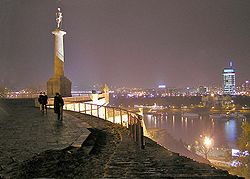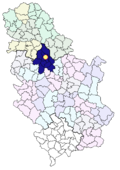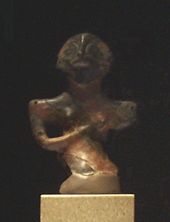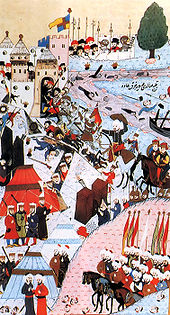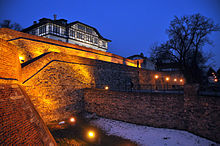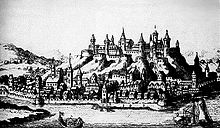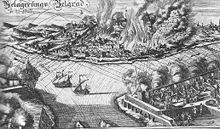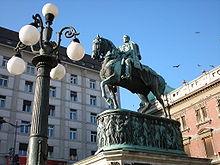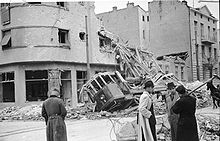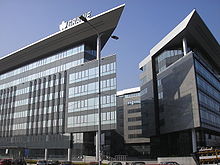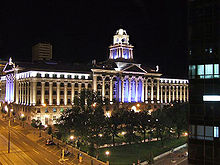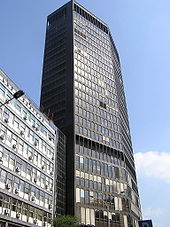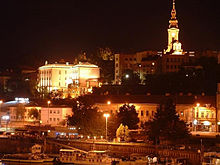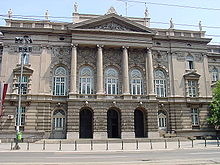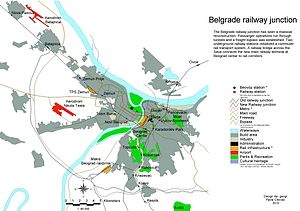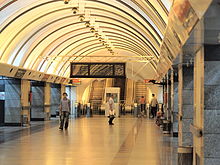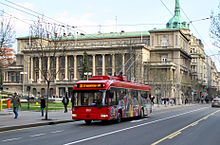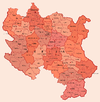- Belgrade
-
For other uses, see Belgrade (disambiguation).
Belgrade
Београд
Beograd— City — 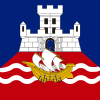
Flag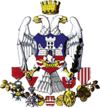
Coat of armsLocation within Serbia Coordinates: 44°49′14″N 20°27′44″E / 44.82056°N 20.46222°ECoordinates: 44°49′14″N 20°27′44″E / 44.82056°N 20.46222°E Country  Serbia
SerbiaDistrict City of Belgrade Municipalities 17 Establishment before 279 BC (Singidunum)[1] Government - Mayor Dragan Đilas (DS) - Ruling parties DS/G17+/SPS-PUPS/LDP Area[2] - City 359.96 km2 (139 sq mi) - Metro 3,222.68 km2 (1,244.3 sq mi) Elevation[3] 117 m (384 ft) Population (2011)[4] - Density 3,283/km2 (8,502.9/sq mi) - Metro  1,718,847
1,718,847- Metro density 506/km2 (1,310.5/sq mi) Time zone CET (UTC+1) - Summer (DST) CEST (UTC+2) Postal code 11000 Area code(s) (+381) 11 Car plates BG Website www.beograd.rs Belgrade
 /ˈbɛlɡreɪd/ (Serbian: Београд or Beograd, [bɛˈɔ˘ɡrad] (
/ˈbɛlɡreɪd/ (Serbian: Београд or Beograd, [bɛˈɔ˘ɡrad] ( listen)) is the capital and largest city of Serbia. It is located at the confluence of the Sava and Danube rivers, where the Pannonian Plain meets the Balkans.[5] The city proper has a population of 1.2 million people, while the official metropolitan area has about 1.7 million. It is one of the largest cities in Southeastern Europe. Its name in English translates to White city.
listen)) is the capital and largest city of Serbia. It is located at the confluence of the Sava and Danube rivers, where the Pannonian Plain meets the Balkans.[5] The city proper has a population of 1.2 million people, while the official metropolitan area has about 1.7 million. It is one of the largest cities in Southeastern Europe. Its name in English translates to White city.One of the largest prehistoric cultures of Europe, the Vinča culture, prospered here in the 6th millennium BC. In antiquity, the area was held by Thraco-Dacians, and after 279 BC the Celts conquered the city, naming it Singidūn.[6] It was conquered during the reign of Augustus, and awarded city rights in the mid 2nd century.[7] It was settled by the Slavs in the 520s, and changed hands several times before it become the capital of King Stephen Dragutin (1282–1316). In 1521 Belgrade was conquered by the Ottomans and became the seat of a Sanjak.[8] It frequently passed from Ottoman to Habsburg rule, which saw the destruction of most of the city during the Austro-Turkish wars. Belgrade was again named the capital of Serbia in 1841. Northern Belgrade remained an Austrian outpost until the breakup of Austria-Hungary in 1918. As a strategic location, the city was battled over in 115 wars and razed to the ground 44 times.[9] Belgrade was the capital of Yugoslavia from 1918 to 1989.
Belgrade has a special administrative status within Serbia.[10] Its metropolitan territory is divided into 17 municipalities, each with its own local council.[11] It covers 3.6% of Serbia's territory, and 22.5% of the country's population lives in the city.[12]
Contents
Geography
Belgrade lies 116.75 metres (383.0 ft) above sea level and is located at confluence of the Danube and Sava rivers, at coordinates 44°49'14" North, 20°27'44" East. The historical core of Belgrade, Kalemegdan, is on the right bank of the rivers. Since the 19th century, the city has been expanding to the south and east, after World War II, New Belgrade was built on the Sava's left bank, merging Belgrade with Zemun. Smaller, chiefly residential communities across the Danube, like Krnjača and Ovča, also merged with the city. The city has an urban area of 360 square kilometres (140 sq mi), while together with its metropolitan area it covers 3,223 km2 (1,244 sq mi). Throughout history, Belgrade has been a crossroads between the West and the Orient.[13]
On the right bank of the Sava, central Belgrade has a hilly terrain, while the highest point of Belgrade proper is Torlak hill at 303 m (994 ft). The mountains of Avala (511 m (1,677 ft)) and Kosmaj (628 m (2,060 ft)) lie south of the city.[14] Across the Sava and Danube, the land is mostly flat, consisting of alluvial plains and loessial plateaus.
Climate
Belgrade's climate exhibits influences of oceanic, humid continental and humid subtropical zones,[15] with four seasons and uniformly spread precipitation. Monthly averages range from 0.4 °C (32.7 °F) in January to 21.8 °C (71.2 °F) in July, with an annual mean of 12.2 °C (54.0 °F). There are, on average, 31 days a year when the temperature is above 30 °C, and 95 days when the temperature is above 25 °C. Belgrade receives about 680 millimetres (27 in) of precipitation a year, with late spring being wettest. The average annual number of sunny hours is 2,025. The sunniest months are July and August, with an average of about 10 sunny hours a day, while December and January are the gloomiest, with an average of 2–2.3 sunny hours a day.[16] The highest officially recorded temperature in Belgrade was +43.1 °C (110 °F) on 24 July 2007,[17] while on the other end, the lowest temperature was −26.2 °C (−15 °F) on 10 January 1893.[16]
Climate data for Belgrade Month Jan Feb Mar Apr May Jun Jul Aug Sep Oct Nov Dec Year Average high °C (°F) 3.5
(38.3)6.5
(43.7)11.9
(53.4)17.5
(63.5)22.5
(72.5)25.3
(77.5)27.3
(81.1)27.3
(81.1)23.7
(74.7)18.1
(64.6)11.0
(51.8)5.3
(41.5)16.7 Average low °C (°F) −2.3
(27.9)−0.2
(31.6)3.3
(37.9)7.8
(46.0)12.1
(53.8)15.0
(59.0)16.3
(61.3)16.1
(61.0)13.0
(55.4)8.3
(46.9)4.0
(39.2)−0.2
(31.6)7.8 Precipitation mm (inches) 49.3
(1.941)44.4
(1.748)49.5
(1.949)58.8
(2.315)70.7
(2.783)90.4
(3.559)66.4
(2.614)51.2
(2.016)51.4
(2.024)40.3
(1.587)54.3
(2.138)57.5
(2.264)684.2
(26.937)Avg. precipitation days 13 12 12 13 14 14 10 9 9 8 12 14 139 Sunshine hours 71.4 88.0 142.8 177.5 226.0 245.5 284.3 265.9 202.9 168.7 89.1 63.0 2,025.1 Source no. 1: WMO [18] Source no. 2: HKO [19] History
Main article: Timeline of Belgrade historySee also: History of SerbiaAncient city
The Neolithic Starčevo- and Vinča cultures prospered in the Belgrade area and dominated the Balkans (as well as parts of Central Europe and Asia Minor) about 7,000 years ago.[6][20][21][22] Some scholars believe that the prehistoric Vinča signs represent one of earliest known forms of alphabet.[23]
The Paleo-Balkan tribes of Thracians and Dacians were the masters of this area prior to the Roman conquest.[24] Belgrade was inhabited by a Thraco-Dacian tribe Singi,[6] while after the Celtic invasion in 279 BC, the Scordisci took the city, naming it "Singidūn" (dun, fortress).[6] In 34-33BC the Roman army under Silanus reached Belgrade. It became the romanized Singidunum in the 1st century AD. In the mid-2nd century, the city was proclaimed a municipium by the Roman authorities, evolving into a full fledged colonia (highest city class) by the end of the century.[7] Apart from the first Christian Emperor of Rome who was born on the territory in modern Serbia – Constantine I known as Constantine the Great[25]) – another early Roman Emperor was born in Singidunum: Flavius Iovianus (Jovian), the restorer of Christianity.[26] Jovian reestablished Christianity as the official religion of the Roman Empire, ending the brief revival of traditional Roman religions under his predecessor Julian the Apostate. In 395 AD, the site passed to the Eastern Roman or Byzantine Empire.[22] Across the Sava from Singidunum was the Celtic city of Taurunum (Zemun), that through Roman and Byzantine times shared a common fate with its "twin brother" (the two cities were connected by a bridge).[27]
Middle Ages
In 442, the area was ravaged by Attila the Hun.[28] In 471, it was taken by Theodoric the Great, who continued into Greece.[29] As the Ostrogoths left for Italy, the Gepids took over the city. In 539 it was retaken by the Byzantines.[30] In 577, some 100,000 Slavs poured into Thrace and Illyricum, pillaging cities and settling down.[31] The Avars and Slavs under Bayan I had by 582 conquered the whole region.[32] According to Byzantine chronicle De Administrando Imperio, the White Serbs had during the rule of Heraclius (610-641) contacted the strategos of Belgrade, asking for lands; they received provinces in the west, towards the Adriatic, which they would rule as foederati.[33] When the Avars were finally destroyed in the 9th century by the Frankish Kingdom, it fell back to Byzantine rule, while Taurunum became part of the Frankish realm (renamed Malevilla).[34] At the same time (around 878), the first record of the name Beligrad appeared, during the rule of the First Bulgarian Empire. For about four centuries, the city remained a battleground between the Byzantine Empire, the Kingdom of Hungary and the First Bulgarian Empire.[35] Basil II (976–1025) installed a garrison in Belgrade.[36] The city hosted the armies of the First and the Second Crusade;[37] while passing through during the Third Crusade, Frederick Barbarossa and his 190,000 crusaders saw Belgrade in ruins.[38]
It became the capital of Stefan Dragutin, a rival-king who received it as a gift from his father-in-law, King Stephen V of Hungary.[39] Under Dragutin from 1284, it became known as the Kingdom of Syrmia, and Dragutin is regarded as the first Serbian king to rule over Belgrade.
Following the Battle of Maritsa in 1371 and the Battle of Kosovo in 1389, the Serbian Empire began to crumble as the Ottoman Empire conquered its southern territory.[40][41] The north resisted through the Serbian Despotate, which had Belgrade as its capital. The city flourished under Stefan Lazarević, son of Serbian prince Lazar Hrebeljanović. Lazarević built a castle with a citadel and towers, of which only the Despot's tower and west wall remain. He also refortified the city's ancient walls, allowing the Despotate to resist the Ottomans for almost 70 years. During this time, Belgrade was a haven for many Balkan peoples fleeing Ottoman rule, and is thought to have had a population of 40, 000 to 50,000 people.[39]
In 1427, Stefan's successor Đurađ Branković had to return Belgrade to the Hungarians, and Smederevo became the new capital. During his reign, the Ottomans captured most of the Serbian Despotate, unsuccessfully besieging Belgrade first in 1440[37] and again in 1456.[42] As it presented an obstacle to their further advance into Central Europe, over 100,000 Ottoman soldiers[43] launched the 1456 Siege of Belgrade, in which the Christian army under Hungarian warlord John Hunyadi successfully defended the city from the Ottomans, wounding Sultan Mehmed II.[44] This battle has been characterized as having "decided the fate of Christendom";[45] the noon bell ordered by Pope Callixtus III commemorates the victory throughout the Christian world to this day.[37][46]
Turkish conquest and Austrian invasions
Seven decades after the initial siege, on August 28, 1521, the fort was finally captured by Sultan Suleyman the Magnificent and his 250,000 soldiers; subsequently, most of the city was razed to the ground and its entire Christian population (including Serbs, Hungarians, Greeks, Armenians, and others) was deported to Istanbul,[37] to the area that has since become known as the Belgrade forest.[47] Belgrade was made the seat of the district (Sanjak), becoming the second largest Ottoman town in Europe at over 100,000 people, surpassed only by Constantinople.[43] Turkish rule also introduced Ottoman architecture, including numerous mosques, increasing the city's Oriental influences.[48] In 1594, a major Serb rebellion was crushed by the Turks. Later, Grand vizier Sinan Pasha ordered the relics of Saint Sava to be publicly torched on the Vračar plateau; in the 20th century, the Temple of Saint Sava was built to commemorate this event.[49]
Occupied by the Habsburgs three times (1688–1690, 1717–1739, 1789–1791), headed by the Holy Roman Princes Maximilian of Bavaria and Eugene of Savoy,[50] and field marshal Baron Ernst Gideon von Laudon respectively, Belgrade was quickly recaptured and substantially razed each time by the Ottomans.[48] During this period, the city was affected by the two Great Serbian Migrations, in which hundreds of thousands of Serbs, led by their patriarchs, retreated together with the Austrians into the Habsburg Empire, settling in today's Vojvodina and Slavonia.[51]
Capital of Serbia
During the First Serbian Uprising, the Serbian revolutionaries held the city from January 8, 1807 until 1813, when it was retaken by the Ottomans.[52] After the Second Serbian Uprising in 1815, Serbia reached semi-independence, which was formally recognized by the Porte in 1830.[53] In 1841, Prince Mihailo Obrenović moved the capital from Kragujevac to Belgrade.[54][55]
On 10 June 1868, Prince Mihailo was walking through the park of Košutnjak, near his country residence in the outskirts of Belgrade, with his wife Katarina and her mother, Princess Anka, when they were shot by assassins. Mihailo and Anka were both killed, and Katarina was wounded.[56]
With the Principality's full independence in 1878, and its transformation into the Kingdom of Serbia in 1882, Belgrade once again became a key city in the Balkans, and developed rapidly.[52][57] Nevertheless, conditions in Serbia as a whole remained those of an overwhelmingly agrarian country, even with the opening of a railway to Niš, Serbia's second city, and in 1900 the capital had only 70,000 inhabitants[58] (at the time Serbia numbered 1,5 million). Yet by 1905 the population had grown to more than 80,000, and by the outbreak of World War I in 1914, it had surpassed the 100,000 citizens, not counting Zemun which then belonged to Austria-Hungary.[59]
The first-ever projection of motion pictures in the Balkans and Central Europe was held in Belgrade, in June 1896 by Andre Carr, a representative of the Lumière brothers. He shot the first motion pictures of Belgrade in the next year; however, they have not been preserved.[60]
World War I / Unified city
"Kalemegdan is the prettiest and most courageous piece of optimism I know."
Gavrilo Princip's assassination of Archduke Franz Ferdinand of Austria, in Sarajevo on June 28, 1914 triggered the start of World War I. Most of the subsequent Balkan offensives occurred near Belgrade. Austro-Hungarian monitors shelled Belgrade on July 29, 1914, and it was taken by the Austro-Hungarian Army under General Oskar Potiorek on November 30. On December 15, it was re-taken by Serbian troops under Marshal Radomir Putnik. After a prolonged battle which destroyed much of the city, between October 6 and October 9, 1915, Belgrade fell to German and Austro-Hungarian troops commanded by Field Marshal August von Mackensen on October 9, 1915. The city was liberated by Serbian and French troops on November 5, 1918, under the command of Marshal Louis Franchet d'Espérey of France and Crown Prince Alexander of Serbia. Decimated as the front-line city, for a while it was Subotica[63] that was the largest city in the Kingdom; still, Belgrade grew rapidly, retrieving its position by the early 1920s.
After the war, Belgrade became the capital of the new Kingdom of Serbs, Croats and Slovenes, renamed the Kingdom of Yugoslavia in 1929. The Kingdom was split into banovinas, and Belgrade, together with Zemun and Pančevo, formed a separate administrative unit.[64]
During this period, the city experienced faster growth and significant modernisation. Belgrade's population grew to 239,000 by 1931 (incorporating the town of Zemun, formerly in Austria-Hungary), and 320,000 by 1940. The population growth rate between 1921 and 1948 averaged 4.08% a year.[65] In 1927, Belgrade's first airport opened, and in 1929, its first radio station began broadcasting. The Pančevo Bridge, which crosses the Danube, was opened in 1935.[66]
World War II
On March 25, 1941, the government of regent Crown Prince Paul signed the Tripartite Pact, joining the Axis powers in an effort to stay out of the Second World War. This was immediately followed by mass protests in Belgrade and a military coup d'état led by Air Force commander General Dušan Simović, who proclaimed King Peter II to be of age to rule the realm. Consequently, the city was heavily bombed by the Luftwaffe on April 6, 1941, when up to 24,000 people were killed.[67][68] Yugoslavia was then invaded by German, Italian, Hungarian, and Bulgarian forces, and suburbs as far east as Zemun, in the Belgrade metropolitan area, were incorporated into a Nazi state, the Independent State of Croatia. Belgrade became the seat of the Nedić regime, headed by General Milan Nedić.
During the summer and fall of 1941, in reprisal for guerrilla attacks, Germans carried out several massacres on Belgrade citizens; in particular, members of the Jewish community were subject to mass shootings at the order of General Franz Böhme, the German Military Governor of Serbia. Böhme rigorously enforced the rule that for every German killed, 100 Serbs or Jews would be shot.[69] The resistance movement in Belgrade was led by Major Žarko Todorović from 1941 to his arrest in 1943.[70]
Just like Rotterdam, which was devastated twice, by both German and Allied bombing, Belgrade was bombed once more during World War II, this time by the Allies on April 16, 1944, killing about 1,100 people. This bombing fell on the Orthodox Christian Easter.[71] Most of the city remained under German occupation until October 20, 1944, when it was liberated by the Red Army and the Communist Yugoslav Partisans. On November 29, 1945, Marshal Josip Broz Tito proclaimed the Federal People's Republic of Yugoslavia in Belgrade (later to be renamed to Socialist Federal Republic of Yugoslavia on April 7, 1963). [72] Higher estimates from the former secret police place the victim count of political persecutions in Belgrade at 10,000.[73]
Communist Yugoslavia
During the post-war period, Belgrade grew rapidly as the capital of the renewed Yugoslavia, developing as a major industrial centre.[57] In 1958, Belgrade's first television station began broadcasting. In 1961, the conference of Non-Aligned Countries was held in Belgrade under Tito's chairmanship. In 1968, major student protests against Tito led to several street clashes between students and the police.
Post-communist history
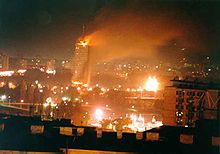 Ušće Tower on fire coused by NATO bombing, 1999
Ušće Tower on fire coused by NATO bombing, 1999
On March 9, 1991, massive demonstrations led by Vuk Drašković were held in the city against Slobodan Milošević.[74] According to various media outlets, there were between 100,000 and 150,000 people on the streets.[75] Two people were killed, 203 injured and 108 arrested during the protests, and later that day tanks were deployed onto the streets to restore order.[76] Further protests were held in Belgrade from November 1996 to February 1997 against the same government after alleged electoral fraud at local elections.[77] These protests brought Zoran Đinđić to power, the first mayor of Belgrade since World War II who did not belong to the League of Communists of Yugoslavia or its later offshoot, the Socialist Party of Serbia.[78]
NATO bombing (during the Kosovo War in 1999) caused substantial damage to the city. Among the sites bombed were the buildings of several ministries, the RTS building, which killed 16 technicians, several hospitals, the Hotel Jugoslavia, the Central Committee building, the Avala TV Tower, and the Chinese embassy.[79]
After the elections in 2000, Belgrade was the site of major street protests, with over half a million people on the streets. These demonstrations resulted in the ousting of president Milošević.[80][81]
Names through history
Belgrade has had many different names throughout history, and in nearly all languages the name translates as "the white city". Serbian name Beograd is a compound of beo (“white, light”) and grad (“town, city”), and etymologically corresponds to several other city names spread throughout the Slavdom: Belgorod, Białogard, Biograd etc.
Name Notes Singidūn(o)- Named by the Celtic tribe of the Scordisci; dūn(o)- means 'lodgment, enclosure, fort', and for word 'singi' there are 2 theories—one being that it is a Celtic word for circle, hence "round fort", and the other that the name is Paleo-Balkan and originated from the Singi, a Thracian tribe that occupied the area prior to the arrival of the Scordisci.[82] Another theory suggests that the Celtic name actually bears its modern meaning—the White Fort (town). Singidūnum Romans conquered the city and Romanized the Celtic name of Singidūn (in turn derived from Paleo-Balkan languages of earlier rulers) Beograd, Београд Slavic name first recorded in 878 as Beligrad in a letter of Pope John VIII to Boris of Bulgaria which translates to "White city/fortress".[83] Alba Graeca "Alba" is Latin for "White" and "Graeca" is the possessive "Greek" Alba Bulgarica Latin name during the period of Bulgarian rule over the city[83] Griechisch-Weißenburg German translation for "Greek White city". Modern German is Belgrad.[83] Castelbianco Italian translation for "White castle". Modern Italian is Belgrado.[83] Nandoralba, Nándorfehérvár, Lándorfejérvár In medieval Hungary. "Fehérvár" means white castle Hungarian - like the Beograd in Serbian. Modern Hungarian is Belgrád.[83] Veligradh(i)on or Velegradha/Βελέγραδα Byzantine name. Modern Greek is Veligradhi (Βελιγράδι). Dar Al Jihad Arabic name during Ottoman empire. Prinz-Eugenstadt Planned German name of the city after World War II, had it remained a part of the Third Reich. The city was to be named after Prince Eugene of Savoy, the Austrian military commander who conquered the city from the Turks in 1717.[84] Administration
 The Old Palace, seat of City Assembly
The Old Palace, seat of City Assembly
Belgrade is a separate territorial unit in Serbia, with its own autonomous city authority.[10] The current mayor is Dragan Đilas of the Democratic Party. The first mayor to be democratically elected after World War II was Zoran Đinđić, in 1996.
The City Assembly of Belgrade has 110 councilors who are elected on four-year terms. The current majority parties are the same as in the Parliament of Serbia (Democratic Party-G17 Plus and Socialist Party of Serbia-Party of United Pensioners of Serbia with the support of Liberal Democratic Party), and in similar proportions, with the Serbian Radical Party and the Democratic Party of Serbia-New Serbia in opposition.[85]
As the capital city, Belgrade also hosts the National Assembly of Serbia, the Government of Serbia and its agencies, and 64 foreign embassies.
Municipalities
See also: Subdivisions of BelgradeThe city is divided into 17 municipalities.[11]
Most of the municipalities are situated on the southern side of the Danube and Sava rivers, in the Šumadija region. Three municipalities (Zemun, Novi Beograd, and Surčin) are on the northern bank of the Sava, in the Syrmia region, and the municipality of Palilula, spanning the Danube, is in both the Šumadija and Banat regions.
Name Area (km²) Population (1991) Population (2002) Barajevo 213 20,846 24,641 Čukarica 156 150,257 168,508 Grocka 289 65,735 75,466 Lazarevac 384 57,848 58,511 Mladenovac 339 54,517 52,490 Novi Beograd 41 218,633 217,773 Obrenovac 411 67,654 70,975 Palilula 451 150,208 155,902 Rakovica 31 96,300 99,000 Savski Venac 14 45,961 42,505 Sopot 271 19,977 20,390 Stari Grad 5 68,552 55,543 Surčin 285 52,000 54,000 Voždovac 148 156,373 151,768 Vračar 3 67,438 58,386 Zemun 154 176,158 136,645 Zvezdara 32 135,694 132,621 TOTAL 3227 1,552,151 1,576,124 Source: Statistical Office of Serbia[12] Panoramic view of New Belgrade across Sava river from Kalemegdan fortress
Demographics
Main article: Demographics of BelgradeSee also: Historical population of BelgradeAccording to the 2002 census, the main population groups according to nationality in Belgrade are: Serbs (1,417,187), Yugoslavs (22,161), Montenegrins (21,190), Roma (19,191), Croats (10,381), Macedonians (8,372), and Muslims by nationality (4,617).[86]
As of August 2, 2008, the city's Institute for Informatics and Statistics has registered 1,542,773 eligible voters, which confirms that Belgrade's population has risen dramatically since the 2002 Census, as the number of the registered voters has almost surpassed the entire population of the city six years before.[87] The official estimate for the end of 2007 (according to the City's Institute for Informatics and Statistics) was 1,630,000, while the number of registered citizens altogether tops at 1,710,000.[88]
Belgrade is home to many ethnicities from all over the former Yugoslavia. Many people came to the city as economic migrants from smaller towns and the countryside, while hundreds of thousands arrived as refugees from Croatia, Bosnia-Herzegovina and Kosovo, as a result of the Yugoslav wars of the 1990s.[89] Between 10,000 and 20,000 [90] Chinese are estimated to live in Belgrade; they began immigrating in the mid-1990s. Block 70 in New Belgrade is known colloquially as the Chinese quarter.[91][92] Many Middle Easterners, mainly from Syria, Iran, Jordan and Iraq, arrived in order to pursue their studies during the 1970s and 1980s, and have remained and started families in the city.[93][94] Afghani and Iraqi Kurdish refugees are among some of the recent arrivals from the Middle East.[95]
Although there are several historic religious communities in Belgrade, the religious makeup of the city is relatively homogenous. The Serbian Orthodox community is by far the largest, with 1,429,170 adherents. There are also 20,366 Muslims, 16,305 Roman Catholics, and 3,796 Protestants. There used to be a significant Jewish community, but following the Nazi occupation, and many Jews' subsequent emigration, their numbers have fallen to a mere 415.[88]
Economy
Main article: Economy of BelgradeBelgrade is the financial centre of Serbia, and is home to the country's National Bank. Many notable companies are based in Belgrade, including Jat Airways, Telekom Srbija, Telenor Serbia, Delta Holding, Elektroprivreda Srbije, Komercijalna banka, Ikarbus, regional centers for AXA,[96] Société Générale, Asus,[97] Intel,[98] Motorola, Dell,[99] Samsung, MTV Adria,[100] Kraft Foods,[101] Carlsberg,[102] Microsoft, OMV, Unilever, Zepter, Japan Tobacco, P&G,[103] and many others.[104] Stocks are traded at the Belgrade Stock Exchange.
New Belgrade is the main business district in the city. The troubled political and economic transition during the 1990s left Belgrade, like the rest of the country, severely affected by an internationally imposed trade embargo. The hyperinflation of the Yugoslav dinar, the highest inflation ever recorded in the world,[105][106] decimated the city's economy. Serbia overcame the problems of inflation in the mid 1990s, and Belgrade has been growing strongly ever since. As of 2009, over 40% of Serbia's GDP is generated by the city, which also has 31,4% of Serbia's employed population.[107] In December 2010, the average monthly net salary in Belgrade was 50,000 RSD (€490, $680).[108] According to the Eurostat methodology, and contrasting sharply to the Balkan region, 53% of the city's households own a computer.[109][110] According to the same survey, 39.1% of Belgrade's households have an internet connection; these figures are above those of the regional capitals such as Sofia, Bucharest and Athens.[109]
Culture
Main article: Culture of Belgrade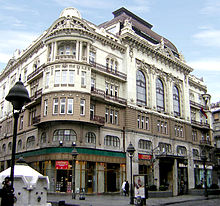 The building of the Serbian Academy of Sciences and Arts, erected in 1922
The building of the Serbian Academy of Sciences and Arts, erected in 1922
Belgrade hosts many annual cultural events, including FEST (Belgrade Film Festival), BITEF (Belgrade Theatre Festival), BELEF (Belgrade Summer Festival), BEMUS (Belgrade Music Festival), Belgrade Book Fair, and the Belgrade Beer Fest.[111] The Nobel prize winning author Ivo Andrić wrote his most famous work, The Bridge on the Drina, in Belgrade.[112] Other prominent Belgrade authors include Branislav Nušić, Miloš Crnjanski, Borislav Pekić, Milorad Pavić and Meša Selimović.[113][114][115] Most of Serbia's film industry is based in Belgrade; the 1995 Palme d'Or winning Underground, directed by Emir Kusturica, was produced in the city.
The city was one of the main centres of the Yugoslav New Wave in the 1980s: VIS Idoli, Ekatarina Velika, Šarlo Akrobata and Električni Orgazam were all from Belgrade. Other notable Belgrade rock acts include Riblja Čorba, Bajaga i Instruktori and Partibrejkers.[116][117] Today, it is the centre of the Serbian hip hop scene, with acts such as Beogradski Sindikat, Škabo, Marčelo, and most of the Bassivity Music stable hailing from or living in the city.[118][119] There are numerous theatres, the most prominent of which are National Theatre, Theatre on Terazije, Yugoslav Drama Theatre, Zvezdara Theatre, and Atelier 212. The Serbian Academy of Sciences and Arts is also based in Belgrade, as well as the National Library of Serbia. Other major libraries include the Belgrade City Library and the Belgrade University Library. Belgrade's two opera houses are: National Theatre and Madlenianum Opera House.
There are many foreign cultural institutions in Belgrade including the Spanish Instituto Cervantes, German Goethe-Institut and French Centre Culturel Français which are all located in the central pedestrian Knez Mihailova Street. Other cultural centres in Belgrade are American Corner, Austrian Cultural Forum, British Council, Chinese Confucius Institute, Canadian Cultural Center, Hellenic Foundation for Culture, Italian Istituto Italiano di Cultura, Culture Center of Islamic Republic of Iran, Azerbaijani Culture Center and Russian Center for Science and Culture.
Following the victory of Serbia's representative Marija Šerifović at the Eurovision Song Contest 2007, Belgrade hosted the Eurovision Song Contest 2008.[120]
Museums
See also: List of museums in BelgradeThe most prominent museum in Belgrade is the National Museum, founded in 1844 and currently closed for reconstruction.Museum houses a collection of more than 400,000 exhibits, (over 5600 paintings and 8400 drawings and prints) including many foreign masters like Titian, El Greco, Rubens, Anthony van Dyck, Renoir, Monet, Picasso, Gauguin, Van Gogh, Gustav Klimt etc. ...And the famous Miroslavljevo Jevanđelje (Miroslav's Gospel).[121] The Ethnographic Museum, established in 1901, contains more than 150,000 items showcasing the rural and urban culture of the Balkans, particularly the countries of the former Yugoslavia.[122] The Museum of Contemporary Art has a collection of around 35,000 works of art including Andy Warhol, Joan Miró, Ivan Meštrović and others since 1900.[123] The Military Museum houses a wide range of more than 25,000 military exhibits dating as far back as to the Roman period, as well as parts of a F-117 stealth aircraft shot down by Serbian army.[124][125] The Museum of Aviation in Belgrade has more than 200 aircraft, of which about 50 are on display, and a few of which are the only surviving examples of their type, such as the Fiat G.50. This museum also displays parts of shot down US and NATO aircraft, such as the F117 and F16[126] The Nikola Tesla Museum, founded in 1952, preserves the personal items of Nikola Tesla, the inventor after whom the Tesla unit was named. It holds around 160,000 original documents and around 5,700 other items.[127] The last of the major Belgrade museums is the Museum of Vuk and Dositej, which showcases the lives, work and legacy of Vuk Stefanović Karadžić and Dositej Obradović, the 19th century reformer of the Serbian literary language and the first Serbian Minister of Education, respectively.[128] Belgrade also houses the Museum of African Art, founded in 1977, which has the large collection of art from West Africa.[129]
With around 95,000 copies of national and international films, the Yugoslav Film Archive is the largest in the region and amongst the 10 largest archives in the world.[130] The institution also operates the Museum of Yugoslav Film Archive, with movie theatre and exhibition hall. The archive's long-standing storage problems were finally solved in 2007, when a new modern depository was opened.[131]
The Belgrade Museum will move into a new building in Nemanjina Street, downtown. The Museum has interesting exhibits such as the Belgrade Gospel (1503), full plate armour from the Battle of Kosovo, and various paintings and graphics. In 2011 construction will start on a new Museum of Science and Technology.
Architecture
See also: List of notable buildings in Belgrade, List of notable streets and squares in Belgrade, List of bridges in Belgrade, Architectural projects under construction in Belgrade, Religious architecture in Belgrade, and Gates of BelgradeBelgrade has wildly varying architecture, from the centre of Zemun, typical of a Central European town,[132] to the more modern architecture and spacious layout of New Belgrade. The oldest architecture is found in Kalemegdan park. Outside of Kalemegdan, the oldest buildings date only from the 18th century, due to its geographic position and frequent wars and destructions.[133] The oldest public structure in Belgrade is a nondescript Turkish turbe, while the oldest house is a modest clay house on Dorćol, from late 18th century.[134] Western influence began in the 19th century, when the city completely transformed from an oriental town to the contemporary architecture of the time, with influences from neoclassicism, romanticism and academic art. Serbian architects took over the development from the foreign builders in the late 19th century, producing the National Theatre, Old Palace, Cathedral Church and later, in the early 20th century, the National Assembly and National Museum, influenced by art nouveau.[133] Elements of Neo-Byzantine architecture are present in buildings such as Vuk's Foundation, old Post Office in Kosovska street, and sacral architecture, such as St. Mark's Church (based on the Gračanica monastery), and the Temple of Saint Sava.[133]
During the period of Communist rule, much housing was built quickly and cheaply to house the huge influx of people from the countryside following World War II, sometimes resulting in the brutalist architecture of the blokovi (blocks) of New Belgrade; a socrealism trend briefly ruled, resulting in buildings like the Trade Union Hall.[133] However, in the mid-1950s, the modernist trends took over, and still dominate the Belgrade architecture.[133]
Tourism
See also: Tourism in SerbiaThe historic areas and buildings of Belgrade are among the city's premier attractions. They include Skadarlija, the National Museum and adjacent National Theatre, Zemun, Nikola Pašić Square, Terazije, Students' Square, the Kalemegdan Fortress, Knez Mihailova Street, the Parliament, the Church of Saint Sava, and the Old Palace. On top of this, there are many parks, monuments, museums, cafés, restaurants and shops on both sides of the river. The hilltop Avala Monument offers views over the city. Josip Broz Tito's mausoleum, called Kuća Cveća (The House of Flowers), and the nearby Topčider and Košutnjak parks are also popular, especially among visitors from the former Yugoslavia.
Beli Dvor or 'White Palace', house of royal family Karađorđević, is open for visitors. The palace has many valuable artworks, including Albrecht Altdorfer, Simon Vouet, Palma Vecchio, Rembrandt, Nicolas Poussin,Franz Xaver Winterhalter and others.[135]
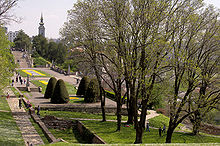 Kalemegdan park
Kalemegdan park
Ada Ciganlija is a former island on the Sava river, and Belgrade's biggest sports and recreational complex. Today it is connected with the right bank of the Sava via two causeways, creating an artificial lake. It is the most popular destination for Belgraders during the city's hot summers. There are 7 kilometres of long beaches and sports facilities for various sports including golf, football, basketball, volleyball, rugby union, baseball, and tennis.[136] During summer there are between 200,000 and 300,000 bathers daily. Clubs work 24 hours a day, organising live music and overnight beach parties.
Extreme sports are available, such as bungee jumping, water skiing and paintballing.[136] There are numerous tracks on the island, where it is possible to ride a bike, go for a walk or go jogging.[136] Apart from Ada, Belgrade has total of 16 islands[137] on the rivers, many still unused. Among them, the Great War Island at the confluence of Sava, stands out as an oasis of unshattered wildlife (especially birds).[138] These areas, along with nearby Small War Island, are protected by the city's government as a nature preserve.[139]
Nightlife
Belgrade has a reputation for offering a vibrant nightlife, and many clubs that are open until dawn can be found throughout the city. The most recognizable nightlife features of Belgrade are the barges (splavovi) spread along the banks of the Sava and Danube Rivers.[140][141][142]
Many weekend visitors—particularly from Bosnia-Herzegovina, Croatia and Slovenia—prefer Belgrade nightlife to that of their own capitals, due to a perceived friendly atmosphere, great clubs and bars, cheap drinks, the lack of language difficulties, and the lack of restrictive night life regulation.[143][144]
Famous alternative clubs include Akademija and the famed KST (Klub Studenata Tehnike) located in the basement of the University of Belgrade Faculty of Electrical Engineering.[145][146][147] One of the most famous sites for alternative cultural happenings in the city is the SKC (Student Cultural Centre), located right across from Belgrade's highrise landmark, the Beograđanka. Concerts featuring famous local and foreign bands are often held at the centre. SKC is also the site of various art exhibitions, as well as public debates and discussions.[148]
A more traditional Serbian nightlife experience, accompanied by traditional music known as Starogradska (roughly translated as Old Town Music), typical of northern Serbia's urban environments, is most prominent in Skadarlija, the city's old bohemian neighbourhood where the poets and artists of Belgrade gathered in the 19th and early 20th centuries. Skadar Street (the centre of Skadarlija) and the surrounding neighbourhood are lined with some of Belgrade's best and oldest traditional restaurants (called kafanas in Serbian), which date back to that period.[149] At one end of the neighbourhood stands Belgrade's oldest beer brewery, founded in the first half of the 19th century.[150] One of the city's oldest kafanas is the Znak pitanja.[151]
The Times reported that Europe's best nightlife can be found in buzzing Belgrade.[152] In the Lonely Planet "1000 Ultimate Experiences" guide of 2009, Belgrade was placed at the 1st spot among the top 10 party cities in the world.[153]
Sport
See also: List of sporting events in Belgrade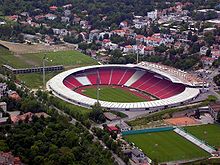 FC Red Star stadium, popularly known as the "Marakana"
FC Red Star stadium, popularly known as the "Marakana"
There are around a thousand sports facilities in Belgrade, many of which are capable of serving all levels of sporting events.[154] Belgrade has hosted several relatively major sporting events recently, including Eurobasket 2005, the 2005 European Volleyball Championship, the 2006 European Water Polo Championship, and the European Youth Olympic Festival 2007. Belgrade was the host city of the 2009 Summer Universiade chosen over the cities of Monterrey and Poznań.[155]
The city launched two unsuccessful candidate bids to organise the Summer Olympic: for the 1992 Summer Olympics Belgrade was eliminated in the third round of International Olympic Committee voting, with the games going to Barcelona. The 1996 Summer Olympics ultimately went to Atlanta.[156]
 the Belgrade Arena
the Belgrade Arena
The city is home to Serbia's two biggest and most successful football clubs, Red Star Belgrade and FK Partizan. Red Star won the 1991 UEFA Champions League (European Cup). The two major stadiums in Belgrade are the Marakana (Red Star Stadium) and the Partizan Stadium.[157] The rivalry between Red Star and Partizan is one of the most famous capital derbies in Europe and has become known as the Eternal derby. The Belgrade Arena is used for various sporting events such as Basketball, volleyball and Davis Cup, and in May 2008 it was the venue of Eurovision Song Contest 2008. Along with Pionir Hall for KK Partizan and KK Crvena zvezda [158][159] while the Tašmajdan Sports Centre is used for swimming competitions and water polo matches.
In recent years, Belgrade has also given rise to several world class tennis players such as Ana Ivanović, Jelena Janković and Novak Đoković. Ivanović and Đoković are the first female and male Serbian players, respectively, to win Grand Slam singles titles. The Serbian national team won the 2010 Davis Cup, beating the French team in the finals played in the Belgrade Arena.[160]
Media
See also: List of media organisations in BelgradeBelgrade is the most important media hub in Serbia. The city is home to the main headquarters of the national broadcaster Radio Television Serbia - RTS, which is a public service broadcaster.[161] The most popular commercial broadcaster is RTV Pink, a Serbian media multinational, known for its popular entertainment programs. The most popular commercial "alternative" broadcaster is B92, another media company, which has its own TV station, radio station, and music and book publishing arms, as well as the most popular website on the Serbian internet.[162][163] Other TV stations broadcasting from Belgrade include Fox Televizija, Avala, Košava, and others which only cover the greater Belgrade municipal area, such as Studio B. Numerous specialised channels are also available: SOS channel (sport), Metropolis (music), Art TV (art), Cinemania (film), and Happy TV (children's programs).
High-circulation daily newspapers published in Belgrade include Politika, Blic, Večernje novosti, Press, Kurir and Danas. There are 2 sporting dailies, Sportski žurnal and Sport, and one economic daily, Privredni pregled. A new free distribution daily, 24 sata, was founded in the autumn of 2006.
Education
Belgrade has two state universities and several private institutions of higher education. The University of Belgrade, founded in 1808 as the "Great School", is the oldest institution of higher learning in Serbia and all of the Balkans.[164] Having developed with the city in the 19th century, quite a few University buildings are a constituent part of Belgrade’s architecture and cultural heritage. With enrollment of nearly 90,000 students, the University is one of the Europe's largest.[165]
There are also 195 primary (elementary) schools and 85 secondary schools. Of the primary schools, there are 162 regular, 14 special, 15 art and 4 adult schools. The secondary school system has 51 vocational schools, 21 gymnasiums, 8 art schools and 5 special schools. The 230,000 pupils are managed by 22,000 employees in over 500 buildings, covering around 1,100,000 m².[166]
Transportation
Main article: Transport in BelgradeBelgrade has an extensive public transport system based on buses (118 urban lines and more than 300 suburban lines), trams (12 lines), and trolleybuses (8 lines).[167] It is run by GSP Beograd and SP Lasta, in cooperation with private companies on various bus routes. Belgrade also has a commuter rail network, Beovoz, now run by the city government. The main railway station connects Belgrade with other European capitals and many towns in Serbia. Travel by coach is also popular, and the capital is well-served with daily connections to every town in the country.
The city is placed along the pan-European corridors X and VII.[5] The motorway system provides for easy access to Novi Sad and Budapest, the capital of Hungary, in the north; Niš to the south; and Zagreb, to the west. Situated at the confluence of two major rivers, the Danube and the Sava, Belgrade has 7 bridges—the two main ones are Branko's bridge and Gazela, both of which connect the core of the city to New Belgrade. With the city's expansion and a substantial increase in the number of vehicles, congestion has become a major problem; this is expected to be alleviated by the construction of a bypass connecting the E70 and E75 highways.[168] Further, an "inner magistral semi-ring" is planned, including a new Ada Bridge across the Sava river, which is expected to ease commuting within the city and unload the Gazela and Branko's bridge.[169]
The Port of Belgrade is on the Danube, and allows the city to receive goods by river.[170] The city is also served by Belgrade Nikola Tesla Airport (IATA: BEG), 12 kilometres west of the city centre, near Surčin. At its peak in 1986, almost 3 million passengers travelled through the airport, though that number dwindled to a trickle in the 1990s.[171] Following renewed growth in 2000, the number of passengers reached approximately 2 million in 2004 and 2005,[172] while during the 2008 the figure peaked at over 2,6 million passengers.[173]
Beovoz is the suburban/commuter railway network that provides mass-transit services in the city, similar to Paris's RER and Toronto's GO Transit. The main usage of today's system is to connect the suburbs with the city centre. Beovoz is operated by Serbian Railways.[174] Belgrade suburban railway system connects suburbs and nearby cities to the west, north and south of the city. It began operation in 1992 and currently has 5 lines with 41 stations divided in two zones.[175]
Belgrade was one of the last big European capitals, and cities with over a million people, to have no metro/subway or other rapid transit system. Construction has been started twice before but was postponed. The Belgrade Metro is considered to be the third most important project in the country, after work on roads and railways. The two projects of highest priority are the Belgrade bypass and Pan-European corridor X. However, the Belgrade Cityrail (S-Bahn) by was opened in 2010 as the first phase of the metro, and includes two underground stations that were built for an earlier abandoned metro project.
International cooperation and honours
List of Belgrade's sister cities, and other forms of city cooperation and friendship:
Country City Year Form 
Corfu 2010 Official sister cities[176][177][178][179][180] 
Coventry 1957 
Chicago 2005 
Lahore 2007 
Ljubljana 2010 
Tel Aviv 1990 
Vienna 2003 Other forms of cooperation and city friendship: 
Athens 1966 Agreement on Friendship and Cooperation 
Banja Luka 2005 Agreement on Cooperation 
Beijing 1980 Agreement on Cooperation[181] 
Berlin 1978 Agreement on Friendship and Cooperation 
Düsseldorf 2004 Agreement on Cooperation 
Kiev 2002 Agreement on Cooperation 
Madrid 2001 Agreement on Cooperation 
Milan 2000 Memorandum of Agreement, City to City Programme 
Moscow 2002 Programme of Cooperation 
Rome 1971 Agreement on Friendship and Cooperation 
Shenzhen 2009 Agreement on Cooperation[182] 
Skopje 2006 Agreement on Cooperation[183] 
Havana Agreement on Friendship[184] Some of the city's municipalities are also twinned to small cities or districts of other big cities, for details see their respective articles.
Belgrade has received various domestic and international honours, including the French Légion d'honneur (proclaimed December 21, 1920; Belgrade is one of four cities outside France, alongside Liège, Luxembourg and Volgograd, to receive this honour), the Czechoslovak War Cross (awarded October 8, 1925), the Yugoslavian Karađorđe's Star with Swords (awarded May 18, 1939) and the SFR Yugoslavian Order of the National Hero (proclaimed on October 20, 1974, the 30th anniversary of the overthrow of Nazi German occupation during World War II).[185] All of these decorations were received for the war efforts during the World War I and World War II.[186] In 2006, Financial Times' magazine Foreign Direct Investment awarded Belgrade the title of City of the Future of Southern Europe.[187][188] In 2008, the Globalization and World Cities Study Group and Network (GaWC), based at the geography department of Loughborough University, published their roster of leading world cities. Belgrade is in the fourth category out of five on this list, being listed in the group of the cities with a "high sufficiency" world presence.[189]
Panoramic view of Belgrade and Sava River from Branko's Bridge
See also
- List of people from Belgrade
References
Bibliography
- Pavić, Milorad (2000). A Short History of Belgrade. Belgrade: Dereta. ISBN 86-7346-117-0.
- Tešanović, Jasmina (2000). The Diary of a Political Idiot: Normal Life in Belgrade. Cleis Press. ISBN 1-57344-114-7.
- Levinsohn, Florence Hamlish (1995). Belgrade : among the Serbs. Chicago: Ivan R. Dee. ISBN 1-56663-061-4.
- Paton, Andrew Archibald (2005-11-04) [1845] (Reprint by Project Gutenberg/Project Rastko). Servia, Youngest Member of the European Family: or, A Residence in Belgrade, and Travels in the Highlands and Woodlands of the Interior, during the years 1843 and 1844.. London: Longman, Brown, Green and Longmans. http://pge.rastko.net/dirs/1/6/9/9/16999/16999-h/16999-h.htm. Retrieved 2009-07-22.
Notes
- ^ "Ancient Period". City of Belgrade. 2000-10-05. http://www.beograd.rs/cms/view.php?id=201172. Retrieved 2010-11-16.
- ^ "Territory". City of Belgrade. http://www.beograd.rs/cms/view.php?id=201197. Retrieved 2009-05-06.
- ^ "Geographical position". City of Belgrade. http://www.beograd.rs/cms/view.php?id=201029. Retrieved 2007-07-10.
- ^ "U Beogradu, Novom Sadu i Novom Pazaru veći broj popisanih ." (in Serbian). Press. 2011-11-02. http://www.emg.rs/vesti/srbija/167603.html. Retrieved 2011-10-21.
- ^ a b "Why invest in Belgrade?". City of Belgrade. http://www.beograd.rs/cms/view.php?id=1299561. Retrieved 2010-10-11.
- ^ a b c d "Discover Belgrade". City of Belgrade. http://www.beograd.rs/cms/view.php?id=320. Retrieved 2009-05-05.
- ^ a b Rich, John (1992). The City in Late Antiquity. CRC Press. p. 113. ISBN 978-0-203-13016-2. http://books.google.com/?id=_uMP91pRf0UC&pg=PA113. Retrieved 2009-05-05.
- ^ "The History of Belgrade". BelgradeNet Travel Guide. http://www.belgradenet.com/belgrade_history_middle_ages.html. Retrieved 2009-05-05.
- ^ Robert Nurden (2009-03-22). "Belgrade has risen from the ashes to become the Balkans' party city". London: Independent. http://www.independent.co.uk/travel/europe/belgrade-has-risen-from-the-ashes-to-become-the-balkans-party-city-1651037.html. Retrieved 2009-05-05.
- ^ a b "Assembly of the City of Belgrade". City of Belgrade. http://www.beograd.rs/cms/view.php?id=201014. Retrieved 2007-07-10.
- ^ a b "Urban Municipalities". Official website. http://www.beograd.rs/cms/view.php?id=201906. Retrieved 2007-07-10.
- ^ a b "2011 Census first estimates". http://www.b92.net/biz/vesti/srbija.php?yyyy=2011&mm=10&dd=19&nav_id=550626. Retrieved 2011-10-19.
- ^ "Geographical Position". Official website. http://www.beograd.rs/cms/view.php?id=201029. Retrieved 2007-07-10.
- ^ "Natural Features". Official site. http://www.beograd.rs/cms/view.php?id=201033. Retrieved 2007-07-16.
- ^ Peel, M. C., Finlayson, B. L. and McMahon, T. A. (2007.). "Updated world map of the Köppen-Geiger climate classification". Hydrol. Earth Syst. Sci. (11): 1641. http://www.hydrol-earth-syst-sci.net/11/1633/2007/hess-11-1633-2007.pdf.
- ^ a b "Climate". Official website. http://www.beograd.rs/cms/view.php?id=201193. Retrieved 2007-07-10.
- ^ m&c News (2007-07-24). "Record-breaking heat measured in Belgrade". http://news.monstersandcritics.com/europe/news/article_1334095.php/Record-breaking_heat_measured_in_Belgrade. Retrieved 2007-08-10.
- ^ "World Weather Information Service - Belgrade". World Meteorological Organisation. http://worldweather.wmo.int/101/c00198.htm. Retrieved 2010-09-08.
- ^ "Climatological Normals of Belgrade". Hong Kong Observatory. http://www.weather.gov.hk/wxinfo/climat/world/eng/europe/iy_al/belgrade_e.htm. Retrieved 2010-09-08.
- ^ Tasic N, Srejovic D, Stojanovic B (1990). Vinca, Centre of the Neolithic culture of the Danubian region. Project Rastko. http://www.rastko.rs/arheologija/vinca/vinca_eng.html. Retrieved 2009-05-05.
- ^ Nikola Tasić; Dragoslav Srejović, Bratislav Stojanović (1990). "Vinča and its Culture". In Vladislav Popović. Vinča: Centre of the Neolithic culture of the Danubian region. Smiljka Kjurin (translator). Belgrade. http://www.rastko.org.rs/arheologija/vinca/vinca_eng.html#_Toc504111710. Retrieved 2006-10-28.
- ^ a b "History (Ancient Period)". Official website. http://www.beograd.rs/cms/view.php?id=201172. Retrieved 2007-07-10.
- ^ Kitson, Peter (1999). Year's Work in English Studies Volume 77. Wiley-Blackwell. p. 5. ISBN 978-0-631-21293-5. http://books.google.com/?id=iWlpqkVMX2YC&pg=PA5&lpg=PA5. Retrieved 2009-05-05.
- ^ "Belgrade Fortress history". Public Enterprise "Belgrade Fortress". http://www.beogradskatvrdjava.co.rs/Belgrade-Fortress-history_2178-74_2176. Retrieved 2011-01-18.
- ^ "Constantine I - Britannica Online Encyclopedia". Britannica.com. http://www.britannica.com/eb/article-9109633/Constantine-I. Retrieved 2009-07-07.
- ^ "Philologic Results-". Artfl.uchicago.edu. http://artfl.uchicago.edu/cgi-bin/philologic/getobject.pl?c.25:1:283.harpers. Retrieved 2009-07-07.
- ^ "City of Belgrade - Ancient Period". Beograd.rs. 2000-10-05. http://www.beograd.rs/cms/view.php?id=201172. Retrieved 2009-07-07.
- ^ The Rome that did not fall: the survival of the East in the fifth century, p.67'
- ^ Roy E. H. Mellor, Eastern Europe: a geography of the Comecon countries, p. 43. Google Book
- ^ Procopius, De Bello Gothico, III:34, quoted in Pohl 1997, pp. 89–90
- ^ History of the Later Roman Empire ... - Google Books. Books.google.com. http://books.google.com/?id=wDIJNvWb48YC. Retrieved 2011-09-15.[page needed]
- ^ Warriors of the Steppe: a military history of Central Asia, 500 B.C. to 1700, p. 76
- ^ Bohlau, 1964, Slavistische Forschungen, Volume 6, p. 103. University of California.
- ^ "History of Zemun". Geocities.com. 1914-07-28. Archived from the original on 2009-10-24. http://web.archive.org/web/20091024203240/http://geocities.com/kadezi/zemunhistory.html. Retrieved 2009-07-07.
- ^ "The History of Belgrade". Belgradenet.com. http://www.belgradenet.com/belgrade_history_ancient.html. Retrieved 2010-11-16.
- ^ Byzantium in the year 1000,p. 121
- ^ a b c d "How to Conquer Belgrade - History". Beligrad.com. 1934-12-16. http://www.beligrad.com/history.htm. Retrieved 2009-07-07.
- ^ "The History of Belgrade". Belgradenet.com. http://www.belgradenet.com/belgrade_history.html. Retrieved 2009-07-07.
- ^ a b "History (Medieval Serbian Belgrade)". Official website. http://www.beograd.rs/cms/view.php?id=201247. Retrieved 2007-07-10.
- ^ "Battle of Maritsa". Encyclopaedia Britannica. http://www.britannica.com/eb/article-9050991/Battle-of-the-Maritsa-River. Retrieved 2007-07-10.
- ^ "Battle of Kosovo". Encyclopaedia Britannica. http://www.britannica.com/eb/article-9046112/Battle-of-Kosovo. Retrieved 2007-07-10.
- ^ Ćorović, Vladimir (1997). "V. Despot Đurađ Branković" (in Serbian). Istorija srpskog naroda. Banja Luka / Belgrade: Project Rastko. ISBN 86-7119-101-X. http://www.rastko.org.rs/rastko-bl/istorija/corovic/istorija/4_5_l.html. Retrieved 2007-07-17.
- ^ a b "The History of Belgrade". Belgradenet.com. http://www.belgradenet.com/belgrade_history_middle_ages.html. Retrieved 2009-07-07.
- ^ Tom R. Kovach. "Ottoman-Hungarian Wars: Siege of Belgrade in 1456". Military History magazine. http://www.historynet.com/magazines/military_history/3030796.html. Retrieved 2007-07-10.
- ^ "Romanian Heritage | Heritage / JohnHunyadi". Wiki.viitorulroman.com. 2006-10-15. Archived from the original on April 16, 2008. http://web.archive.org/web/20080416055137/http://wiki.viitorulroman.com/pmwiki.php/Heritage/JohnHunyadi. Retrieved 2009-07-07.
- ^ "Hungary: A Brief History". Mek.oszk.hu. http://www.mek.oszk.hu/02000/02085/02085.htm. Retrieved 2010-11-16.
- ^ "The Rough Guide to Turkey: Belgrade Forest". Rough Guides. http://www.roughguides.co.uk/website/travel/Destination/content/default.aspx?titleid=104&xid=idh573385336_0211. Retrieved 2009-05-05.
- ^ a b "History (Turkish and Austrian Rule)". Official website. http://www.beograd.rs/cms/view.php?id=201251. Retrieved 2007-07-10.
- ^ Aleksov, Bojan (December 2003). "Nationalism In Construction: The Memorial Church of St. Sava on Vračar Hill In Belgrade". Balkanologie VII (47): 52–53. http://balkanologie.revues.org/index494.html?file=1. Retrieved 2010-09-15.
- ^ "Belgrade Fortress: History". Razgledanje.tripod.com. 2004-08-23. http://razgledanje.tripod.com/tvrdjava/english.htm. Retrieved 2009-07-07.
- ^ Medaković, Dejan (1990). "Tajne poruke svetog Save" Svetosavska crkva i velika seoba Srba 1690. godine". Oči u oči. Belgrade: BIGZ (online reprint by Serbian Unity Congress library). ISBN 978-86-13-00903-0. Archived from the original on 2007-09-30. http://web.archive.org/web/20070930183543/http://www.suc.org/culture/library/Oci/tajne-poruke-svetoga-save-16-03-03.html. Retrieved 2007-05-17.
- ^ a b "History (Liberation of Belgrade)". Official website. http://www.beograd.rs/cms/view.php?id=201255. Retrieved 2007-07-10.
- ^ Pavkovic, Aleksandar (2001-10-19). Nations into States: National Liberations in Former Yugoslavia. The Australian National University.
- ^ "History". City of Kragujevac official website. http://www.kragujevac.rs/History-152-2. Retrieved 2010-09-15.
- ^ "History (Important Years Through City History)". Official website. http://www.beograd.rs/cms/view.php?id=201239. Retrieved 2007-07-10.
- ^ Celia Hawkesworth, Voices in the Shadows: Women and Verbal Art in Serbia and Bosnia, Google Books, 2000. Retrieved 16 June 2010.[page needed]
- ^ a b "History (The Capital of Serbia and Yugoslavia)". Official website. http://www.beograd.rs/cms/view.php?id=201259. Retrieved 2007-07-10.
- ^ Jan Lahmeyer (2003-02-03). "The Yugoslav Federation: Historical demographical data of the urban centers". www.populstat.info. http://www.populstat.info/Europe/yugoslft.htm. Retrieved 2007-05-17.
- ^
 "Belgrade and Smederevo" in the 1913 Catholic Encyclopedia - Retrieved on 2007-10-16.
"Belgrade and Smederevo" in the 1913 Catholic Encyclopedia - Retrieved on 2007-10-16. - ^ Kosanovic, Dejan (1995). "Serbian Film and Cinematography (1896-1993)". The history of Serbian Culture. Porthill Publishers. ISBN 1-870732-31-6. http://www.rastko.org.rs/isk/dkosanovic-cinematography.html. Retrieved 2007-07-10.
- ^ "Serbia :: Belgrade". Balkanology. http://www.balkanology.com/serbia/article_belgrade.html. Retrieved 2009-07-07.
- ^ "Rebecca West's Constantine the Poet". Serbworldusa.com. http://www.serbworldusa.com/REBECCA%20WEST.html. Retrieved 2010-11-16.
- ^ "Serbia :: Vojvodina". Balkanology. http://www.balkanology.com/serbia/article_vojvodina.html. Retrieved 2009-07-07.
- ^ ISBN 86-17-09287-4: Kosta Nikolić, Nikola Žutić, Momčilo Pavlović, Zorica Špadijer: Историја за трећи разред гимназије, Belgrade, 2002, pg. 144
- ^ Petrović, Dragan; Arold, R (2001). "Industrija i urbani razvoj Beograda" (PDF). Industrija 21 (1–4): 87–94. ISSN 0350-0373. PMID 0350-03730101087P. http://scindeks.nb.rs/article.aspx?artid=0350-03730101087P&redirect=ft. Retrieved 2007-07-10.
- ^ "Twentieth Century - Innovations in Belgrade". Serbia-info.com (Government of Serbia website). Archived from the original on 2008-01-18. http://web.archive.org/web/20080118092237/http://www.serbia-info.com/g3/images/1930-50-e.htm. Retrieved 2007-07-21.
- ^ Stevenson, William (1976). A Man Called Intrepid, The Secret War. New York: Ballantine Books. p. 230. ISBN 0-345-27254-4.
- ^ "Part Two the Yugoslav Campaign". The German campaign in the Balkans (Spring 1941). United States Army Center of Military History. 1986 [1953]. CMH Pub 104-4. http://www.history.army.mil/books/wwii/balkan/20_260_2.htm. Retrieved 2009-07-07.
- ^ Rubenstein, Richard L; Roth, John king (2003). Approaches to Auschwitz: The Holocaust and Its Legacy. Westminster John Knox Press. p. 170. ISBN 0-664-22353-2. http://www.questia.com/library/book/approaches-to-auschwitz-the-holocaust-and-its-legacy-by-john-k-roth-richard-l-rubenstein.jsp.
- ^ Zbornik dokumenata vojnoistorijskog instituta: TOM XIV, Knjiga 1
- ^ "Anniversary of the Allied Bomb Attacks Against Belgrade". Radio-Television of Serbia. 2008-04-17. http://www.spc.rs/eng/anniversary_allied_bomb_attacks_against_belgrade. Retrieved 2009-05-05.
- ^ "Tekstovi (Texts)". Napredniklub.org. http://www.napredniklub.org/tekstovi.php?subaction=showfull&id=1255532834&archive=&start_from=&ucat=1&. Retrieved 2010-11-16.
- ^ "Izmedju Srpa i Cekica (Between the hammer and sickle)". Scribd.com. 2009-04-20. http://www.scribd.com/doc/14429469/Izmedju-Srpa-i-Cekica. Retrieved 2010-11-16.
- ^ "Prvi udarac Miloševićevom režimu" (in Serbian). Danas. 2006-03-09. http://www.danas.rs/20060309/hronika1.html. Retrieved 2007-07-10.
- ^ James L. Graff (1991-03-25). "Yugoslavia: Mass bedlam in Belgrade". TIME. http://www.time.com/time/magazine/article/0,9171,972607-1,00.html. Retrieved 2007-07-10.
- ^ "Srbija na mitinzima (1990–1999)" (in Serbian). Vreme. 1999-08-21. http://www.vreme.com/arhiva_html/450/2.html. Retrieved 2007-07-10.
- ^ "History (Disintegration Years 1988–2000)". Official website. http://www.beograd.rs/cms/view.php?id=201267. Retrieved 2007-07-10.
- ^ Jane Perlez (1997-02-23). "New Mayor of Belgrade: A Serbian Chameleon". The New York Times. http://select.nytimes.com/gst/abstract.html?res=F40616F83B5A0C708EDDAB0894DF494D81&n=Top%2fReference%2fTimes%20Topics%2fPeople%2fD%2fDjindjic%2c%20Zoran. Retrieved 2007-05-17.
- ^ "NATO bombing". Official website. http://www.beograd.rs/cms/view.php?id=201271. Retrieved 2007-05-17.
- ^ "Parties, citizens mark October 5". B92. 2007-10-05. http://www.b92.net//eng/news/politics-article.php?yyyy=2007&mm=10&dd=05&nav_category=90&nav_id=44315. Retrieved 2009-05-07.
- ^ "October 5, 2000". City of Belgrade. http://www.beograd.rs/cms/view.php?id=201275. Retrieved 2009-05-07.
- ^ "Ancient Period". Official website. http://www.beograd.rs/cms/view.php?id=201172. Retrieved 2009-01-31.
- ^ a b c d e "History (Byzantine Empire)". Official website. http://www.beograd.rs/cms/view.php?id=201243. Retrieved 2007-05-17.
- ^ "Opasno neznanje ili nešto više". Danas. http://www.danas.rs/vesti/dijalog/opasno_neznanje_ili_nesto_vise.46.html?news_id=145464. Retrieved 2008-12-29.
- ^ "Councilors of the Assembly of the City of Belgrade". Official site. http://www.beograd.rs/cms/view.php?id=201942. Retrieved 2007-07-16.
- ^ "Facts (Population)". Official website. http://www.beograd.rs/cms/view.php?id=201201. Retrieved 2007-07-10.
- ^ "Birački spisak" (in Serbian). Zavod za informatiku i statistiku Grada Beograda. 2007. https://zis.beograd.gov.rs/spisak.php.
- ^ a b "Statistical yearbook of Belgrade" (pdf, link IE only). Zavod za informatiku i statistiku Grada Beograda. 2009. p. 66. https://zis.beograd.gov.rs/upload/G_2009S.pdf.
- ^ Refugee Serbs Assail Belgrade Government: The Washington Post, Tuesday, June 22, 1999.
- ^ "Stranci tanje budžet". Novosti.rs. http://www.novosti.rs/code/navigate.php?Id=14&status=jedna&vest=120710&datum=2008-05-06. Retrieved 2010-11-16.
- ^ "Kinezi Marko, Miloš i Ana" (in Serbian). Kurir. 2005-02-20. http://arhiva.kurir-info.rs/Arhiva/2005/februar/19-20/B-01-19022005.shtml. Retrieved 2007-07-18.
- ^ Biljana Vasić (2001-01-15). "Kineska četvrt u bloku 70" (in Serbian). Vreme. http://www.vreme.com/arhiva_html/471/10.html. Retrieved 2007-07-18.
- ^ Vesna Peric Zimonjic (2005-12-07). "A unique friendship club in Belgrade". Dawn - International. Archived from the original on 2007-09-27. http://web.archive.org/web/20070927225101/http://www.dawn.com/2005/12/07/int17.htm. Retrieved 2007-07-17.
- ^ Francesca Ciriaci (1999-04-11). "Government, public diverge in assessment of Kosovo crisis". Jordan Times. http://www.jordanembassyus.org/041199003.htm. Retrieved 2007-07-18.
- ^ "Chinese and Iraqi immigrants receive quiet welcome". international. 2007-05-31. http://ins.onlinedemocracy.ca/index.php?name=News&file=article&sid=9214. Retrieved 2007-10-04.
- ^ "Svjetski lider u osiguranju Aksa odabrao Beograd za centar regiona". Trazimkredit.com. 2011-06-17. http://www.trazimkredit.com/novosti/1783-svjetski-lider-u-osiguranju-aksa-odabrao-beograd-za-centar-regiona.html. Retrieved 2011-09-15.
- ^ "Asus otvorio regionalni centar u Beogradu :: emportal :: Ekonomske vesti iz Srbije". Emportal.rs. http://www.emportal.rs/vesti/srbija/62935.html. Retrieved 2010-11-16.
- ^ "Centar kompanije 'Intel' za Balkan u Beogradu - Srbija deo 'Intel World Ahead Program'". E kapija. http://www.ekapija.com/website/sr/page/140159. Retrieved 2009-07-07.
- ^ [1]
- ^ "Vesti dana : MTV se preselio u Beograd : POLITIKA". Politika.rs. http://www.politika.rs/rubrike/vesti-dana/MTV-se-preselio-u-Beograd.lt.html. Retrieved 2009-07-25.
- ^ "Beograd će biti regionalni centar :: emportal :: Ekonomske vesti iz Srbije". Emportal.rs. http://www.emportal.rs/vesti/srbija/40020.html. Retrieved 2010-11-16.
- ^ "Beograd konkuriše Beču". Politika. 2008-02-21. http://www.politika.rs/rubrike/Ekonomija/Beograd-konkurishe-Bechu.lt.html. Retrieved 2009-05-05.
- ^ "Procter&Gamble Belgrade". Pgbalkans.com. http://www.pgbalkans.com/yu/contact.asp. Retrieved 2010-11-16.
- ^ "JTI u Srbiju ulaže oko $100 mil" (in Serbian). B92 Biz. 2007-04-24. http://www.b92.net/biz/vesti/srbija.php?yyyy=2007&mm=04&dd=24&nav_id=243493&fs=1. Retrieved 2007-05-19.
- ^ Watkins, Thayer. "The Worst Episode of Hyperinflation in History: Yugoslavia 1993-94". Episodes of Hyperinflation. San José State University Department of Economics. http://www.sjsu.edu/faculty/watkins/hyper.htm#YUGO. Retrieved 2007-07-26.
- ^ Taylor, Bryan. "Countries that Suffered the Greatest Inflation in the Twentieth century" (Word document). The Century of Inflation. Global Financial Data. pp. 8, 10. Archived from the original on 2007-08-08. http://web.archive.org/web/20070808143908/http://www.globalfindata.com/articles/Century_of_Inflation.doc. Retrieved 2007-07-26.
- ^ "Privreda Beograda" (in Serbian). Economic Chamber of Belgrade. http://www.kombeg.org.rs/Komora/centri/CentarZaEkonomskuPolitiku.aspx?veza=3014. Retrieved 2010-01-19.
- ^ "Prosečne zarade, Beograd" (in Serbian). Economic Chamber of Belgrade. December 2010. p. 3. http://www.kombeg.org.rs/Slike/CeEkonPolitikaPrestrIRazvoj/pokazatelji/binder%20IZVESTAJ%20dec.%202010..pdf. Retrieved 2011-09-14.
- ^ a b "U Srbiji sve više računara". Politika.rs. http://www.politika.rs/rubrike/Drustvo/U-Srbiji-sve-vishe-rachunara.lt.html. Retrieved 2009-07-07.
- ^ Almost 98% of companies in Serbia are computerised - Economy.rs
- ^ "Culture and Art (Cultural Events)". Official website. http://www.beograd.rs/cms/view.php?id=201299. Retrieved 2007-07-10.
- ^ "The biography of Ivo Andrić". The Ivo Andrić Foundation. http://www.ivoandric.org.rs/html/biography.html. Retrieved 2007-05-18.
- ^ "Borislav Pekić - Biografija" (in Serbian). Project Rastko. http://www.rastko.org.rs/knjizevnost/nauka_knjiz/pekic-biograf.html. Retrieved 2007-05-19.
- ^ Joseph Tabbi (2005-07-26). "Miloš Crnjanski and his descendents". Electronic Book Review. http://www.electronicbookreview.com/thread/internetnation/sumatrism. Retrieved 2007-07-10.
- ^ "Meša Selimović - Biografija" (in Bosnian). Kitabhana.net. http://www.xs4all.nl/~eteia/kitabhana/Selimovic_Mehmed_Mesa/Biografija.html. Retrieved 2007-07-10.
- ^ "Beogradska rock scena je otišla u ilegalu" (in Serbian). Glas.ba. http://www.glas.ba/index.php?p=2&clid=3342&kadid=71&otv=13&pg=1. Retrieved 2011-01-18.
- ^ John Shepherd (2005). Continuum encyclopedia of popular music of the world. 3-7. Continuum. p. 142. ISBN 978-0-8264-7436-0.
- ^ Aleksandar Pavlić (2005-02-09). "Beogradski Sindikat: Svi Zajedno" (in Serbian). Popboks magazine. http://www.popboks.com/albumi/beogradskisindikat.shtml. Retrieved 2007-05-23.
- ^ S. S. Todorović (2004-01-30). "Liričar među reperima" (in Serbian). Balkanmedia. http://www.balkanmedia.com/m2/doc/3184-1.shtml. Retrieved 2007-05-23.
- ^ "Serbian ballad wins Eurovision Song Contest - Belgrade hosts in 2008". Helsingin Sanomat. 2007-05-14. http://www.hs.fi/english/article/Serbian+ballad+wins+Eurovision+Song+Contest+-+Belgrade+hosts+in+2008+/1135227223254. Retrieved 2007-07-10.
- ^ Tatjana Cvjetićanin. "From the history of the National Museum in Belgrade". National Museum of Serbia. http://www.narodnimuzej.rs/code/navigate.php?Id=75. Retrieved 2007-07-27.
- ^ "Museums 3". Official website. http://www.beograd.rs/cms/view.php?id=201167. Retrieved 2007-07-10.
- ^ "Museums 2". Official website. http://www.beograd.rs/cms/view.php?id=201055. Retrieved 2007-07-10.
- ^ "Museums". Official website. http://www.beograd.rs/cms/view.php?id=201283. Retrieved 2007-07-10.
- ^ "Military Museum". Lonely Planet. http://www.lonelyplanet.com/serbia/belgrade/sights/museum/military-museum. Retrieved 2010-01-18.
- ^ "Lična karta Muzeja ratnog vazduhoplovstva" (in Serbian). Museum of Air force Belgrade. Archived from the original on May 28, 2006. http://web.archive.org/web/20060528075833/http://www.muzejrv.org/istorija/istorija.html. Retrieved 2007-05-19.
- ^ "About the museum". Nikola Tesla Museum. http://www.tesla-museum.org/meni_en/nt.php?link=muzej/m&opc=sub2. Retrieved 2007-07-10.
- ^ "City of Belgrade - Museums 1". Official website. http://www.beograd.rs/cms/view.php?id=201051. Retrieved 2007-07-10.
- ^ "Cultural institutions:Museum of African Art". Official website. http://www.beograd.rs/cms/view.php?id=202308. Retrieved 2007-07-10.
- ^ "Action programme 2006 for Serbia: Support to the Yugoslav Film Archive" (PDF). European Agency for Reconstruction. 2006-01-01. http://www.ear.europa.eu/serbia/main/documents/2006Media.pdf. Retrieved 2007-07-10.
- ^ "New Depository for the Yugoslav Film Archive's treasure". SEECult.org, Culture Portal of Southeastern Europe. 2007-06-07. Archived from the original on 2007-10-11. http://web.archive.org/web/20071011202918/http://seecult.org/english/module-News-display-sid-211.html. Retrieved 2007-07-10.
- ^ Nicholas Comrie, Lucy Moore (2007-10-01). "Zemun: The Town Within the City". B92 Travel. http://www.b92.net/eng/travel/index.php?nav_id=38986. Retrieved 2007-05-17.
- ^ a b c d e Zoran Manević. "Architecture and Building". MIT website. http://web.mit.edu/most/www/ser/Belgrade/zoran_manevic.html. Retrieved 2007-05-19.
- ^ Prof. Dr. Mihajlo Mitrović (2003-06-27). "Seventh Belgrade triennial of world architecture". ULUS. http://www.ulus.org.rs/ENGLISH/Exhibitions/TriennialA/TriennialA.htm. Retrieved 2007-05-19.
- ^ Laura Wolfs (2010-06-21). "A Palacial Tour". Balkan Insight. http://old.balkaninsight.com/en/main/life_and_style/28895/. Retrieved 2011-09-18.
- ^ a b c "Ada Ciganlija". Tourist Organization of Belgrade. http://www.tob.co.rs/eng/index.php?option=com_content&task=view&id=167&Itemid=281. Retrieved 2010-09-15.
- ^ Ana Nikolov (2005-07-29). Beograd – grad na rekama. Institut za Arhitekturu i Urbanizam Srbije. http://www.ekapija.com/website/sr/page/17516. Retrieved 2007-06-05.
- ^ "Zbogom, oazo!" (in Serbian). Kurir. 2006-05-23. http://arhiva.kurir-info.rs/Arhiva/2006/maj/23/B-01-23052006.shtml. Retrieved 2007-06-05.
- ^ Beoinfo (2005-08-04). "Prirodno dobro "Veliko ratno ostrvo" stavljeno pod zaštitu Skupštine grada" (in Serbian). Ekoforum. http://www.ekoforum.org/index/vest.asp?vID=181. Retrieved 2007-06-05.
- ^ Eve-Ann Prentice (2003-08-10). "Why I love battereBelgrade". London: The Guardian Travel. http://travel.guardian.co.uk/article/2003/aug/10/observerescapesection1. Retrieved 2007-05-19.
- ^ Seth Sherwood (2005-10-16). "Belgrade Rocks". The New York Times. http://www.nytimes.com/2005/10/16/travel/16belgrade.html?ex=1287115200&en=4cd8ccf41a41542c&ei=5088. Retrieved 2007-05-19.
- ^ Barbara Gruber (2006-08-22). "Belgrade's Nightlife Floats on the Danube". Deutsche Welle. http://www.dw-world.de/dw/article/0,2144,2129528,00.html. Retrieved 2007-05-19.
- ^ "Slovenci dolaze u jeftin provod" (in Serbian). Glas Javnosti. 2004-12-21. http://www.b92.net/info/vesti/pregled_stampe.php?yyyy=2004&mm=12&dd=21&nav_id=158386. Retrieved 2007-07-10.
- ^ "U Beograd na vikend-zabavu" (in Croatian). Večernji list. 2006-01-06. Archived from the original on 2006-01-06. http://www.b92.net/info/vesti/pregled_stampe.php?yyyy=2006&mm=01&dd=08&nav_id=184523. Retrieved 2007-06-15.
- ^ Gordy, Eric D. (1999). "The Destruction of Musical Alternatives". The Culture of Power in Serbia: Nationalism and the Destruction of Alternatives. Penn State Press. pp. 121–122. ISBN 0-271-01958-1. http://books.google.com/?id=WqoZsrmYZQIC&dq=Belgrade+KST. Retrieved 2007-07-10.
- ^ "Intro". Club "Akademija". http://www.akademija.net/remote/?call=2&lg=2. Retrieved 2007-07-10.
- ^ "Klub Studenata Tehnike - O nama" (in Serbian). http://www.kst.org.rs/.
- ^ David Galić (2010-02-22). "Studentski Kulturni Centar". Balkan Insight. http://www.balkaninsight.com/en/article/studentski-kulturni-centar. Retrieved 2011-01-19.
- ^ "Skadarlija". Tourist Organisation of Belgrade. http://www.tob.rs/en/see.php?kat=9. Retrieved 2011-01-19.
- ^ "Beogradska Industrija Piva AD". SEE News. http://www.seenews.com/profiles/companies/cs_bip_beogradska_industrija_piva/. Retrieved 2009-05-05.
- ^ "Znamenite građevine 3" (in Serbian). Official site. http://www.beograd.rs/cms/view.php?id=1319. Retrieved 2007-07-10.
- ^ Scurlock, Gareth (2008-11-04). "Europe's best nightlife". London: Official site. http://www.timesonline.co.uk/tol/travel/holiday_type/music_and_travel/article5082856.ece. Retrieved 2008-04-11.
- ^ "The world's top 10 party towns". The Sydney Morning Herald. 2009-11-09. http://www.smh.com.au/travel/the-worlds-top-10-party-towns-20091118-im4q.html. Retrieved 2010-03-16.
- ^ "Sport and Recreation". Official website. http://www.beograd.rs/cms/view.php?id=201508. Retrieved 2007-07-10.
- ^ "Universiade 2009 (Belgrade)". FISU. Archived from the original on 2008-02-09. http://web.archive.org/web/20080209234741/http://www.fisu.net/site/page_1068.php. Retrieved 2007-05-19.
- ^ "Factsheet: The Olympic Summer Games Update – January 2010". International Olympic Committee. http://www.olympic.org/Documents/Reference_documents_Factsheets/The_Olympic_Summer_Games.pdf. Retrieved 2010-11-08.
- ^ "Sport and Recreation (Stadiums)". Official website. http://www.beograd.rs/cms/view.php?id=201754. Retrieved 2007-07-10.
- ^ "Sport and Recreation (Sport Centers and Halls)". Official website. http://www.beograd.rs/cms/view.php?id=201758. Retrieved 2007-07-10.
- ^ "Venues". EYOF Belgrade 2007. http://www.beograd2007.org/index.php?option=com_content&task=view&id=20&Itemid=131&limit=1&limitstart=3&lang=en. Retrieved 2007-07-30.
- ^ "Tipsarevic sends Serbia into first Davis Cup final". Davis Cup official website. 2010-09-19. http://www.daviscup.com/en/news/articles/tipsarevic-sends-serbia-into-first-davis-cup-final.aspx. Retrieved 2010-09-20.
- ^ "Medijski javni servis građana" (in Serbian). Radio Television of Serbia. 2008-11-13. http://www.rts.rs/page/rts/sr/javniservis/RTS+50/story/251/I+danas/27294/Medijski+javni+servis+gra%C4%91ana.html.
- ^ Jared Manasek (2005-01). "The Paradox of Pink". Columbia Journalism Review. Archived from the original on 2007-09-30. http://web.archive.org/web/20070930033327/http://www.cjr.org/issues/2005/1/manasek-paradox.asp. Retrieved 2007-05-19.
- ^ "B92 na 8.598. mestu na svetu" (in Serbian). B92. 2006-09-01. http://www.b92.net/info/vesti/index.php?yyyy=2006&mm=09&dd=01&nav_category=15&nav_id=210237&fs=1. Retrieved 2007-05-19.
- ^ "The University of Belgrade – The Seedbed of University Education". Faculty of Law of University of Belgrade. http://www.ius.bg.ac.rs/eng/university_of_belgrade.htm. Retrieved 2007-05-18.
- ^ "Word by the Rector". University of Belgrade. http://www.bg.ac.rs/eng/uni/en_recrektora.php. Retrieved 2011-01-19.
- ^ "Education and Science". City of Belgrade. http://www.beograd.rs/cms/view.php?id=201008. Retrieved 2007-07-10.
- ^ "Statistics". Public Transport Company "Belgrade". http://www.gsp.rs/english/statistic.htm. Retrieved 2007-05-19.
- ^ "Belgrade Bypass, Serbia". CEE Bankwatch network. http://www.bankwatch.org/project.shtml?w=147584&s=1961998. Retrieved 2007-05-19.
- ^ "1. faza prve deonice Unutrašnjeg magistralnog poluprstena" (in Serbian) (PDF). Belgrade Direction for Building and Real Estate Land/EBRD. 2005-07-01. Archived from the original on August 9, 2007. http://web.archive.org/web/20070809064808/http://www.ebrd.com/projects/eias/34913s.pdf. Retrieved 2007-09-15.
- ^ "Luka Beograd AS - Istorijat [History of the Port of Belgrade]" (in Serbian). Port of Belgrade. http://www.lukabeograd.com/ONama/Istorijat.html. Retrieved 2010-10-11.
- ^ "Airports and Flying fields". Aviation guide through Belgrade. http://www.vazduhoplovnivodic.rs/eng/eng_letelista.htm. Retrieved 2009-05-05.
- ^ "Regionalni centar putničkog i kargo saobraćaja" (in Serbian). Danas. 2005-05-20. http://www.danas.rs/20050520/ekonomija1.html. Retrieved 2007-07-10.
- ^ "www.beg.aero | Nikola Tesla Belgrade Airport | News". Airport-belgrade.rs. http://www.airport-belgrade.rs/code/navigate.php?Id=63. Retrieved 2009-07-07.
- ^ "Železnice Srbije - Red voznje za Beovoz i BG:VOZ". Serbian railways. http://www.srbrail.rs/redvoznje1/Beovoz.aspx.
- ^ Grad Beograd - Beovoz
- ^ "International Cooperation". Official website. http://www.beograd.rs/cms/view.php?id=1225698. Retrieved 2007-07-10.
- ^ "Beograd: Međunarodni odnosi". Stalna konferencija gradova i opština Srbije. Archived from the original on September 27, 2007. http://web.archive.org/web/20070927021427/http://www.skgo.org/php/opstine/detalji.php?Id=12&IdSvojstva=MO. Retrieved 2007-06-18.
- ^ "Council okays peace committees: Lahore and Chicago to be declared twin cities". The Post. 2007-01-28. http://thepost.com.pk/Arc_CityNews.aspx?dtlid=79932&catid=3&date=01/28/2007&fcatid=14. Retrieved 2007-05-16.
- ^ "Bratimljenje Beograda i Krfa". B92. http://www.b92.net/info/vesti/index.php?yyyy=2010&mm=02&dd=25&nav_category=12&nav_id=414000. Retrieved 2010-02-25.
- ^ Gradonačelnici Beograda i Ljubljane potpisali sporazum o bratimljenju dva glavna grada
- ^ "Sister Cities". Beijing Municipal Government. http://www.ebeijing.gov.cn/Sister_Cities/Sister_City/. Retrieved 2008-09-23.
- ^ "Saradnja Beograda i Šendžena". B92. http://www.b92.net/info/vesti/index.php?yyyy=2009&mm=07&dd=11&nav_category=12&nav_id=370774. Retrieved 2009-07-11.
- ^ "City of Belgrade - International Cooperation". Beograd.rs. http://www.beograd.rs/cms/view.php?id=1225698. Retrieved 2010-01-25.
- ^ "Invitation for fraternization of Havana and Belgrade". Mfa.gov.rs. http://www.mfa.gov.rs/Bilteni/Engleski/b290507_e.html#N10. Retrieved 2010-04-17.
- ^ "Received Decorations". Official website. http://www.beograd.rs/cms/view.php?id=201227. Retrieved 2007-05-16.
- ^ "Beograd - grad heroj". RTV Pink. 2009-11-06. http://www.rtvpink.com/vesti/vest.php?id=26907. Retrieved 2009-11-15.
- ^ "European Cities of the Future 2006/07". fDi magazine. 2006-02-06. Archived from the original on 2007-09-27. http://web.archive.org/web/20070927004828/http://www.fdimagazine.com/news/fullstory.php/aid/1543. Retrieved 2007-07-10.
- ^ Aleksandar Miloradović (2006-09-01). "Belgrade - City of the Future in Southern Europe" (PDF). TheRegion, magazine of SEE Europe. http://www.seeurope.net/files2/pdf/rgn0906/13_Belgrade_CityOfTheFutureInSEE.pdf. Retrieved 2007-07-10.
- ^ "The World According to GaWC 2008". Globalization and World Cities Study Group and Network (GaWC). Loughborough University. http://www.lboro.ac.uk/gawc/world2008t.html. Retrieved 2009-05-07.
External links
- City of Belgrade Official Website
- Tourist Organization of Belgrade
- Belgrade Chamber of Commerce
- Belgrade Stock Exchange
- Environmental Atlas of Belgrade, Institute of Public Health of Belgrade
- Map of Belgrade with directory of companies
- Belgrade travel guide from Wikitravel
Statistical regions of Serbia Vojvodina · Belgrade · Šumadija and Western Serbia · Southern and Eastern Serbia · Kosovo and Metohija Categories:
Categories:- Hero Cities of the Socialist Federal Republic of Yugoslavia
- Former capitals of Serbia
- Belgrade
- Capitals in Europe
- Districts of Serbia
- Metropolitan areas of Serbia
- Statistical regions of Serbia
- Port cities in Serbia
- Ancient cities in Serbia
- Populated places established in the 3rd century BC
- Populated places on the Danube
- Šumadija
Wikimedia Foundation. 2010.

